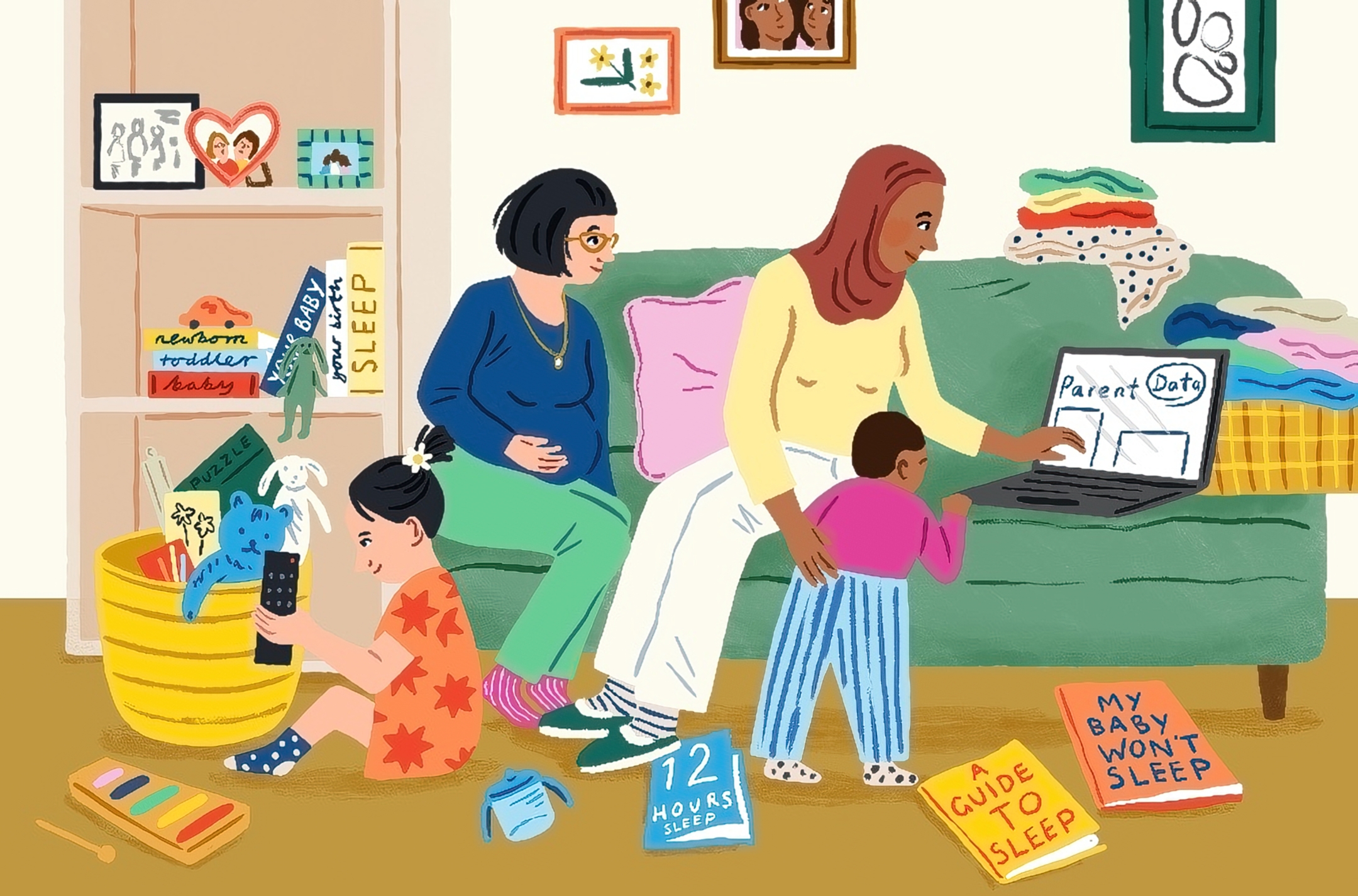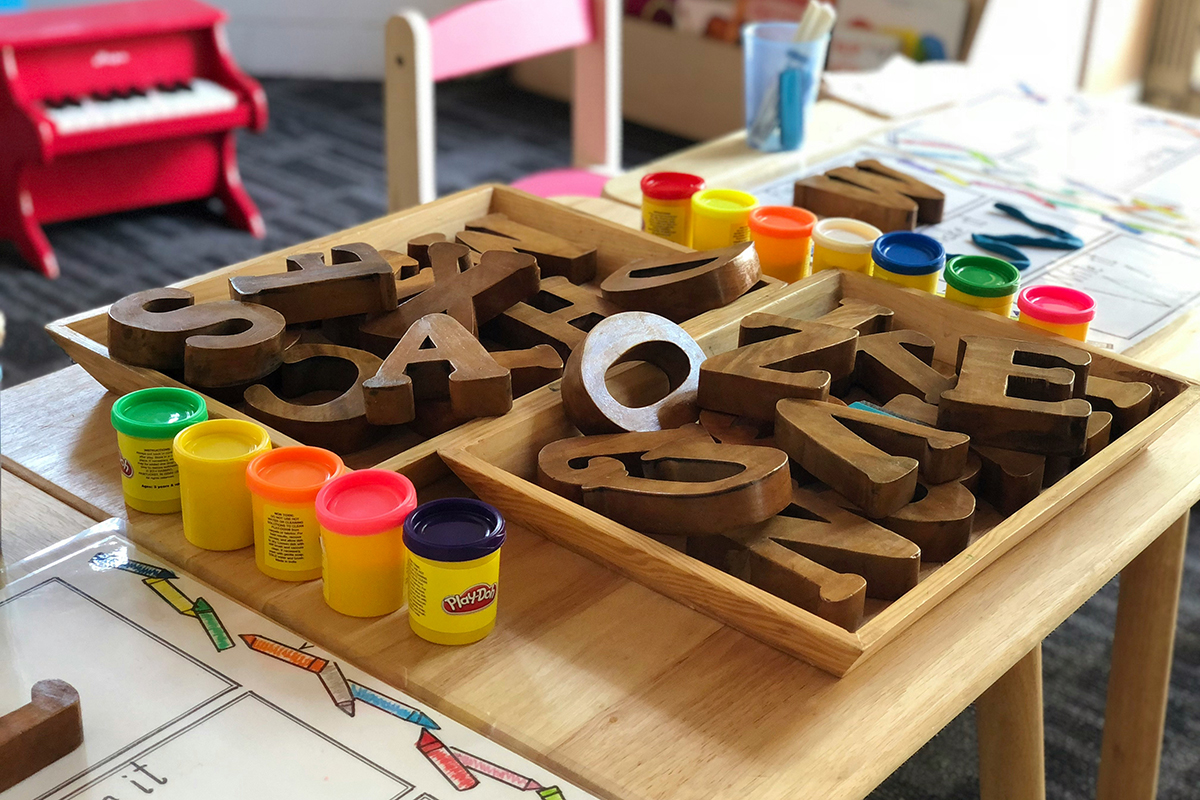Child care is a big deal. It comes up in our homes, and it’s a topic of intense policy discussion and debate. Child care is an equity issue, a cost issue, and a possible reason for declining fertility. For parents, it is a huge pain point.
The parents I talk to about it often have a hint of exasperation: Child care is so expensive, and also, I can’t find it. This feels like a total conundrum. If I’m willing to pay what seems like an insane amount, how is it possible that I still cannot get a spot!?
This question is inherently linked to the core policy discussion here: Should the government subsidize child care? So below, I outline a lesson in the basic economics of child care. Why is it expensive, but also hard to find? What is wrong with the market, and how would subsidies fix it? And, finally, what are the economic arguments to do so?

Why is child care so expensive?
The average cost of child care in the U.S. is in the range of $6,000 to $15,000 a year, and often much more in cities or higher-rent areas. To understand this cost, let’s do some simple math.
Imagine you want to run an infant care center for 12 children. Generally, this requires a ratio of four children to one caregiver at any given time. In order to provide comprehensive care, you need to be open before work and after work; let’s say, 7 a.m. to 6 p.m. That’s 11 hours a day, five days a week, with at least three people working at any given time for a total of 165 person-hours per week.
You’re competing with jobs like Amazon and Whole Foods for workers, which means you need to provide competitive salaries and benefits. Based on national estimates of child care costs, let’s assume that the cost is $21/hour in wages and benefits. Putting this together, you’re looking at about $180,000 in personnel costs per year.
The child care center also needs to pay rent, purchase insurance, and cover expenses like furniture and supplies. Rent will depend on location, and there are regulations about how much space you need per child. Let’s say we’re in a medium-sized city (such as Providence, RI) with the relevant regulations. In this case, you’re looking at about $20,000 a year in rent. Insurance is another $10,000 per year. Supplies — let’s be generous and say $10,000 a year.
The cost for running this child care center for 12 infants is $220,000 per year. To break even, you’d need to charge each infant about $1,530 per month. To be clear: with these numbers, that’s where you break even — no profit, no extra payment to the director or owner. These calculations also ignore other random costs such as marketing, licensing, lawyers, etc.
There isn’t any secret here; most of the cost is in people, and that’s because taking care of kids is a lot of work, and you need a lot of people to do it well. And those people should be fairly compensated, both because this job is of value and because that’s what is necessary to compete in the labor market for employees.
It’s common to blame regulation for high child care costs, and that is true, in a sense. Regulations dictate the adult-child ratio, which drives costs. But having more adults is also of value, so this isn’t a useless regulation.
Why is child care so hard to find?
The above discussion explains why child care costs what it does. What it doesn’t explain is why it’s also hard to find. Child care centers should, in principle, be scalable. They do not require workers with advanced training or specialized locations; it should be possible for entrepreneurs to create more.
Generally, in a market like this, if there is demand, economists would expect prices to rise. As prices rise, that would bring in new suppliers — people who didn’t necessarily want to run a child care center at the lower prices, but now that there is more money in it, they’re up for the challenge. This would expand the supply of centers to meet demand. (If you ever took a course in microeconomics, this is where the professor would draw up those supply and demand curves.)
For much of the economy, the market works great; supply and demand are matched, so the world contains as many (say) gyms as people want, but not more. With child care, however, we often see “excess demand.” Some people may be willing to pay the listed price for child care, but cannot find a spot. But we do not see what we would expect to happen next, which is an increase in prices and an expansion of supply (more child care centers) at those higher prices. The result is that parents cannot find child care at all, even if they are willing to pay more.
The reason this happens is that if prices rise too much, people find other options.
Let’s go back to our earlier thought experiment. What would happen if you raised the price of child care for parents to $3,000 per month rather than $1,500? At this price, you would have more people who wanted to open centers because it’s a better business now. However, you wouldn’t see as much expansion in demand because, at that price, parents will go with other options (even if they aren’t as desirable). One parent staying home, family help, a nanny share, or some secret option C. All of these have possible benefits and costs, many of which are specific to the preferences and constraints of individual families.
Overall, if prices go up too much, demand dries up fast. That creates a limit to how high prices can rise before people look for different solutions. The result is excess demand, and there is no clear way the market will fix it.
The upshot: the economics of the current situation clearly predict what we see.
How would child care subsidies fix these problems?
Child care subsidies refer to any payment from the government, either to families to help them pay for child care or to child care centers to help finance their operations. Such subsidies would address this problem by effectively allowing centers to raise prices without those prices being experienced by parents.
We could provide subsidies directly to child care providers, which would encourage more child care centers to open without higher prices. Or we could give individual families subsidies, which would allow them to pay higher prices and encourage more entry. From an economic standpoint, these are equivalent. From a practical perspective, it is probably easier to subsidize providers because it means fewer payments.
Subsidies could be partial or universal here. They could be big enough to make child care free, but there would also be significant progress if they were simply large enough to expand the pool of centers or lower the price by some amount, even if not to zero.
So should the government subsidize child care?
In general, the reason governments intervene in markets is when there is a reason to think that fixing the market would benefit more than just the people who are in it. This is what we call positive externalities.
Education is the classic example. Governments heavily subsidize K-12 education because there are positive social benefits when people are educated. They are more informed citizens, but also they make more money, which then benefits the government in terms of taxes. Without subsidies, individuals would get less education than is optimal (on average) because they wouldn’t take into account the benefits to the broader society.
Without these externalities, there is no argument for government intervention into markets, even if there is excess demand. There was a lot of excess demand for tickets to Taylor Swift’s Eras Tour, but there was no case for government subsidies there because the benefits are fully internal to each individual.
Whether the government should subsidize child care depends on whether you think there are positive externalities. I think the answer is pretty clearly yes, for three reasons.
First, access to child care allows more women to stay in the labor market, which generates more tax revenue. This is true both in the short and long term because as women maintain attachment to the labor market, they ultimately have higher wages.
Second, there is an argument that high-quality government-subsidized childcare could be higher quality than many of the child care options that families are forced to utilize without this.
Third, as fertility has declined, there is an argument — popular on both the left and right, I will note — that higher fertility is socially desirable. One policy change that has been shown to improve fertility, at least a bit, is improved child care access.
The upshot: I think there are good economic arguments for government subsidies.
How would this get done?
Movement on this is likely to happen at the state and local levels. Two states — Vermont and New Mexico — have already passed legislation to subsidize child care. They present different models for payment. New Mexico is funding universal child care with money from oil and gas revenue. Vermont uses a payroll tax. Other states are talking about this, too.
Legislation of this type is popular with families, but it’s expensive, and the primary barrier will be finding ways to fund it that are politically feasible. The existing examples show it can be done, though.
If you’re looking to learn more, Moms First is doing amazing, focused work to get this done at the state and local levels.
The bottom line
- Child care is expensive, mainly due to personnel costs; you need a lot of people to do it well.
- Child care is hard to find because prices can’t rise high enough to attract more providers without parents choosing other options (one parent staying home, a nanny share, etc.).
- Child care subsidies would make care more available and affordable by letting centers charge lower prices without parents bearing the full cost.
















Log in
FWIW, the U.S. government does provide limited child care subsidies for families with low incomes. Many types of providers can participate, including centers, in-home, and family, friend, and neighbor care providers (though it’s not cheap or easy to become eligible). These subsidies, however, pay providers a reimbursement rate that is just a fraction of the actual cost of care, meaning they have to charge more for families paying out of pocket. The subsidies also only reach a fraction of families who could benefit – not to mention all the families who make too much to be eligible for assistance but not enough to afford the cost of care. The existing business model is broken – we absolutely need expanded government investment to build a functioning, affordable, and quality child care system, so parents (mothers!) can work if they want, so children can receive the early childhood education we know is so important for their long-term development, and so all families can thrive!
And echoing others – early childhood ed is absolutely a skilled profession and child care workers deserve pay and job quality that is equal to the skill and value they bring our families.
I agree with the other comments and with the article’s general takeaways (I also agree that it requires special training). As an older mom of 1, I had to quash any hopes of a second child simply because of the high cost of childcare. We can’t afford two kids in daycare. Both my spouse and I are highly trained and have relatively high incomes and yet in our area, we wouldn’t be able to afford rent if we had to pay for 2x daycare.
Childcare costs are truly wild, and yet I know the workers at my child’s preschool are barely scraping by and several of them have second jobs to make ends meet. It’s really exacerbated in the Bay Area, where I am, because the cost of living is so crazy high. I am an attorney but childcare costs for my two kids eats up 50% of my pre-tax income (we are a dual-income house thankfully).
One thing you didn’t mention which doesn’t help soaring costs but does help somewhat with supply is the expansion of universal TK/Pre-K. California gradually rolled out universal T-K for 4-year-olds and this is the first school year it’s fully available for any kid turning 4 by September 1. Many of those 4-year-olds would have otherwise been in preschool, and most preschools here typically have 2-year-olds to 4-year-olds. With the declining 4-year-old enrollment, many preschools have expanded the capacity for their 2s and 3s classes since they already had the staff and space to take on a certain number of kids. I don’t think it was CA’s main driver for implementing T-K but increased availability of care for the younger kids has been an interesting side effect.
The economic modeling here assumes elasticity of supply but I’m really not sure you can assume that with the unemployment rate at 4.3% and childcare being incredibly labor intensive. Your subsidy might just mean more money chasing the same pool of resources. Unfortunately with childcare we haven’t found any technological ways to increase the productivity of the labor, so the usual answer is: “immigration”. Not going to have much luck with that currently. Of course, if we get a big spike in unemployment due to AI taking all the jobs or whatever then subsidies would work out.
Emily. I love what you have to say 99% of the time. As an early childhood educator I applaud this article and your support of government subsidies. One thing: please understand that caring for and educating young children (and working with their families) absolutely requires special training and skill. It can be as simple as a course in child development (minimal requirement in most states) or as extensive as full graduate degrees. One of the reasons caregivers are not better trained is because it costs too much. Most centers do not have the revenue to cover the cost of professional development and that is not acceptable. And most educators do not make enough to pay for additional coursework or degree programs. I could on forever but the message is this – caregiving and education are professional careers that require ongoing training and learning. Our children deserve nothing less. And subsidizing it is the most important and equitable way to address this.
The article suggests that subsidizing providers directly may be more administratively efficient than subsidizing families. However, doesn’t this approach risk creating inefficiencies by favoring formal childcare centers over the diverse care arrangements families actually use? Given that many families rely on informal providers—relatives, in-home caregivers, or flexible arrangements that accommodate non-standard work hours—wouldn’t demand-side subsidies (direct payments to families) better reflect revealed preferences and allow the market to allocate resources toward the care models that families actually value? This seems particularly relevant for shift workers and those with atypical schedules who may be poorly served by traditional center-based care with fixed hours.
I’ve researched this intensely because daycare is $500 – $700/week ($26-$36K/year) in my area (Chicago). When I say intensely, I mean I’ve looked into opening a daycare myself and modeled out the financials. It drives me insane that daycare is so expensive, but the workers are paid so little.
Although everything in this article is true and most daycares barely break even, the margins for operating a daycare in upper-middle class neighborhoods are often 20-30%. The franchise fees alone (think – Goddard, Primrose, etc.) usually take up 10% of revenue, which is like 30-50% of the profit. The larger the center and the older the average child age, the higher the profit margin typically. The start-up fees are high, but I’ve come to the conclusion that there are owners and many private equity firms making a lot of money off of these daycares. This makes sense – private equity wouldn’t be in this space if there wasn’t money to be made. Kindercare, The Gardner School, Bright Horizons, etc. are all owned by private equity.
If you do not want to support people profiting off of underpaid daycare workers, make sure to research your options thoroughly and understand what kind of business you’re supporting. I recommend looking at Indeed.com to see employee reviews, which can be quite revealing.
I think another way to investigate how staff feel is to ask how long lead teachers have been with a center. We toured Bright Horizons and it seemed fine, but the staff turnover was astoundingly high. At the center where we wound up, several people had worked there for decades.
I definitely wouldn’t want to be supporting private equity with my daycare fees, but I feel for families who need options. It took us almost 2 years to get off a waitlist. One place told me people get on waitlists *before they are even pregnant*. My friend was told to get on a waitlist for her second child. When she said she wasn’t expecting one yet, they said, neither is anyone else on the waitlist. If BH has the spot you so desperately need, you might take it even if you don’t love what you’re supporting.
This is so important. You cite 3K as the unreasonably high monthly cost, though last I checked that’s exactly what our daycare charged for infants (I’m out of the loop since my kids are older than daycare age now). And there was still a huge waitlist. One family got on the list for their first child…and eventually got in 7 years later, just in time for their second child to attend a single year there. And yes most of the cost is people. I know salaries were 80% of their budget.
Perhaps special training isn’t required by law in some places, though our daycare did require lead teachers to have certain early childhood education credits. And of course everyone was trained in some basics like CPR and mandated reporter stuff. I’d say it’s not quite as entry level as Walmart or something.
Also it would be nice for people to have the option to work part time or stay home with their children. Let’s face it, a lot of people don’t get that option for many reasons.
thank you for this break down! I would question the statement that child care doesn’t take special training.
well, we may not require it in this current market, there is an awful lot to know about child development, pedagogy of care, etc. that would be important for staff in a truly well functioning childcare system
We agree that, in an ideal scenario, child care providers would have access to specialized training in early childhood education. Unfortunately, that doesn’t line up with the current reality and shortage of workers that many centers face. We changed the language here to say “advanced training” to reflect that many providers do, in fact, have some prior education or on-the-job training. Thanks!
Have you looked at all into how the UK does subsidies? They are very common here, for example I will get 20 free hours as soon as my son turns 3 in North Wales. However there is still a real shortage of child care spots. I have seen people state different reasons from regulations making it hard to open new locations to the subsidies being too low to actually run a center on. I wonder if anyone has actually done research on this or if it is all too new.